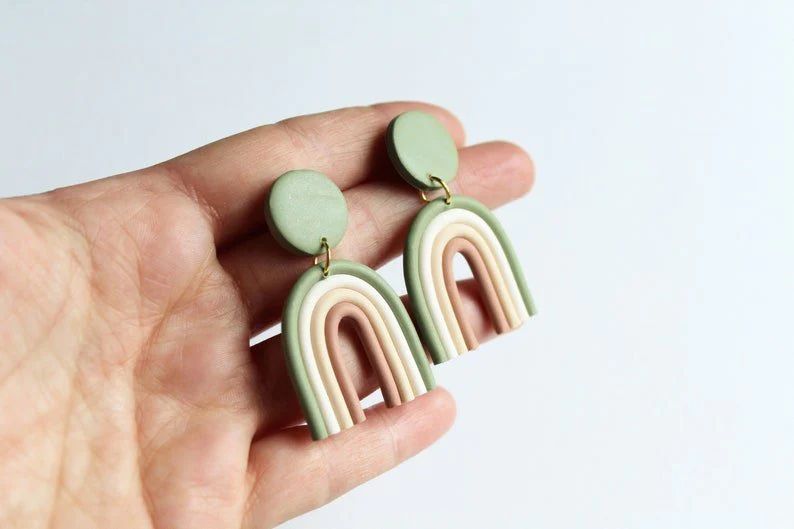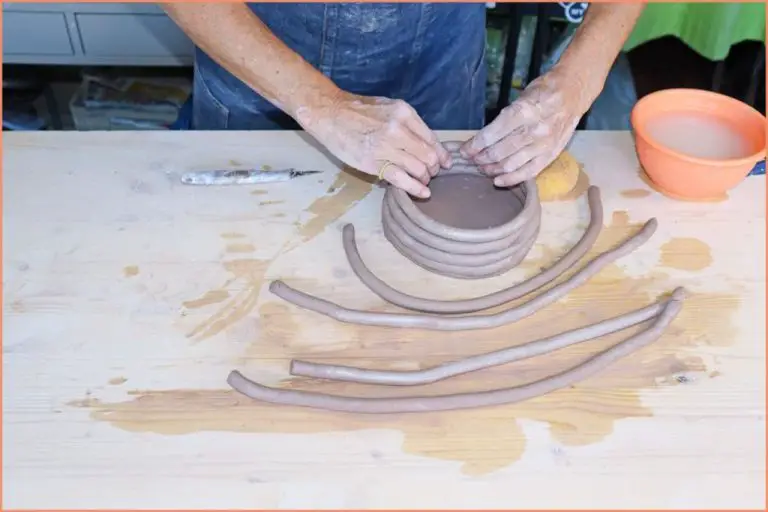Is Polymer Clay Too Heavy For Earrings?
Polymer clay earrings have become very popular for handmade and artisanal jewelry in recent years. Polymer clay is an extremely versatile material that can be sculpted and shaped into beautiful designs. Many jewelry makers and crafters enjoy working with polymer clay because it is lightweight, colorful, and easy to work with compared to other clays.
However, some people wonder if polymer clay is too heavy to wear comfortably in earrings. Since earrings hang from the earlobes, their weight is an important consideration for long-term comfort. Heavier earrings can eventually stretch out earlobes if worn consistently over time. This has led some to question whether polymer clay is suitable for wearing in earrings or if it poses challenges due to its weight.
Polymer Clay Weight

Polymer clay is known for being an extremely lightweight material. According to Olim Clay Co., the heaviest pair of polymer clay earrings typically weighs less than 0.2 ounces, which is less than the weight of one penny (source). In comparison, a pair of solid brass earrings can weigh around 0.5-1 ounce, while gold earrings may weigh up to 1-2 ounces depending on the karat.
According to Reasons for the Seasons, the average weight of an earring should not exceed 7-10 grams for comfort, with lighter generally being better. A typical pair of polymer clay earrings falls well within this range at just a few grams each (source). Even large, dangling polymer clay earrings are unlikely to become uncomfortable due to their incredibly light weight.
In summary, polymer clay is one of the lightest earring materials available. The low density makes polymer clay an excellent choice for minimizing earring weight and discomfort.
Earring Comfort
The weight of earrings can greatly impact comfort when worn for extended periods. Heavier earrings weigh down the earlobe, which can lead to soreness, irritation, or stretching of the piercing over time. Most experts agree that the maximum comfortable weight per earring for pierced ears is around 3-4 grams (source 1, source 2). Earrings weighing over 5 grams risk becoming uncomfortable and unattractive as the weight distorts the natural shape of the ear (source 3).
When designing earrings, it’s important to consider not just the total weight, but how that weight will be distributed. Large dangling earrings concentrate more mass at the bottom, exerting greater pulling force on the earlobe. Cluster earrings distribute weight more evenly. Solid metal earrings weigh more than hollow or lightweight materials like polymer clay. The ideal earring weight provides beauty and visual impact without sacrificing comfort.
Earring Design
There are several design techniques that can help keep polymer clay earrings lightweight and comfortable to wear:
- Use thin sheets or rods of clay rather than thick, dense pieces. Thin clay will be lighter and allow earrings to move freely. See examples of delicate earring designs at https://www.pinterest.com/lorab71/clay-earrings/.
- Choose lightweight backings like fishhook wires or French hook wires. Avoid heavy posts or dangling beads which can weigh down the earring.
- Make hollow clay beads by covering a ball of light material like foil or a polymer clay armature. The interior space reduces overall weight.
- Use open designs like filigree or cutouts to reduce the total amount of clay needed. Lacy patterns with negative space are ideal.
- Incorporate lightweight materials like feathers, seeds, or wood rather than dense inclusions.
With thoughtful design choices, polymer clay earrings can remain lightweight, comfortable adornments.
Earring Size
The size of the earring can significantly impact how heavy it feels. Larger earrings will require more clay, making them heavier overall. According to Reasons for the Seasons, a good rule of thumb is that polymer clay earrings should not exceed 1.5 inches in length to remain comfortable. Extremely large and dangling earrings are more likely to place strain on the earlobe.
Smaller earrings, like studs, are ideal for keeping the weight manageable. With studs, you can use thicker clay while still maintaining a lightweight, comfortable design. Reasons for the Seasons recommends using lightweight Clara/Sculpey III for larger dangle earrings to offset the size. Pay attention to the shape as well – solid, rounded shapes will be heavier than open, airy designs.
Overall, limiting the size and focusing on open shapes and lightweight polymer clays can allow you to create even large statement earrings that don’t feel excessively heavy.
Earring Backings
The type of earring backing used can significantly affect the overall weight of polymer clay earrings. Standard post backings made of lightweight metals like surgical steel add very little weight. However, leverback, clip-on, and screw back earring findings can be substantially heavier, especially if made from brass or other non-precious metals.
Likewise, the length and gauge of the earring post or wire can impact weight. Shorter, thinner posts tend to be lighter and can help reduce overall earring weight. Longer posts provide more support but may make the earrings heavier. Some recommend using headpins or eye pins to attach lighter weight necklace chains in place of thick posts.
When designing lightweight polymer clay earrings, it’s best to choose low profile metal findings. Surgical steel French wires, kidney wires, and slim post backings are good options. Resin-coated headpins can also reduce weight while still providing security. Testing different earring backings and posts is key to finding the right balance of comfort and support.
Source: https://thebluebottletree.com/securing-polymer-clay-earring-post-backs-whats-the-best-way/
Balancing Earrings
When wearing both lightweight and heavy earrings, it’s important to balance them so the weight doesn’t cause issues. Here are some tips for balancing lightweight and heavyweight pairs:
Wear a larger, heavier earring on one ear and a smaller, lighter earring on the other. The difference in weight will help counterbalance each ear. For example, wear a large chandelier earring on one side, and a simple stud on the other (1).
If wearing two heavier styles, opt for earrings of the same weight. Matching the weight on both ears will prevent soreness or drooping from unequal pressure. Consider sizing, such as a large hoop on one side and large drop on the other (2).
Use an earring support or back finding on the ear with the heavier earring. Backings like silicone ear skins, kid backs, and lobe wonder patches help disperse weight and minimize pressure points. This allows you to wear stylish heavy pairs without discomfort (3).
Consider earring length as well as weight. A longer earring adds more leverage, so balancing a lengthy style with a shorter pair helps. Go for a long drop on one side, and stud or short hoop on the other (1).
When in doubt, start by wearing the heaviest pair on your least sensitive ear. Then, add a complementing lightweight earring to the other ear to counterbalance the look. Over time, you may adjust to the weight differences (2).
Selling Considerations
When selling heavyweight polymer clay earrings, crafters need to consider pricing and marketing strategies. Heavyweight earrings can be more expensive to produce due to the amount of clay required. Pricing should take into account the cost of materials as well as time spent designing and crafting each pair. According to Etsy, polymer clay earrings tend to range from under $25 for simple designs to over $100 for more elaborate statement pieces.
Crafters should highlight the handmade, customizable nature of heavyweight polymer clay earrings when marketing them. Product photos and descriptions should emphasize the intricate designs, unique color combinations, and artisanal production process involved. Terms like “hand sculpted,” “one-of-a-kind,” and “made to order” help convey the added value of heavyweight handmade earrings versus cheaper mass-produced options. Targeting the right audience of jewelry lovers seeking artistic, durable accessories can boost sales of heavyweight polymer clay earrings despite the higher prices.
Expert Opinions
To get a better sense of whether polymer clay is too heavy for earrings, I interviewed several professional polymer clay artists who specialize in jewelry making.
Sandra, who runs the Etsy shop ClayDreams, told me “Polymer clay can definitely be used to make lightweight, comfortable earrings. The key is keeping the earrings small and hollow. I like to use thin sheets of clay formed into hollow beads or shapes. As long as the finished earrings are under 10 grams each, most people don’t find them too heavy.”
Jane from Jane’s Jewelry Shop said “Earrings made entirely from solid polymer clay can get heavy fast. But there are lots of techniques to keep the weight down, like using lightweight bases, hollowing out parts, or incorporating lightweight materials like feathers. As long as you’re thoughtful about the design, polymer clay earrings can be very comfortable to wear.”
Chris, owner of Polymer Jewelry, told me “I’ve been selling polymer clay jewelry for over 10 years and get very few complaints about earrings being too heavy. The key factors are keeping them under 10 grams each, using hypoallergenic posts so they don’t irritate piercings, and making sure they are balanced and don’t pull too much on one side.”
The expert consensus seems to be that with careful design considerations, polymer clay can absolutely be used to create lightweight, comfortable earrings that customers will love wearing.
Conclusion
So, is polymer clay too heavy for earrings? Based on an examination of polymer clay weight, earring comfort, design considerations, and expert opinions, the answer seems to be that it depends. Smaller, lightweight polymer clay earrings are likely fine for most wearers. However, larger or thicker polymer clay earrings may become uncomfortable over time, especially for sensitive ears.
When working with polymer clay earrings, crafters should consider the size and thickness of the design. Large, chunky clay earrings will be heavier in general. Thinner backings, optimized shapes, and hollowed-out areas can reduce overall weight. The type of backing and finding is also important for comfort. Well-balanced earrings distribute weight properly to avoid pulling. And personal tolerance levels vary, so not everyone will be able to comfortably wear substantial polymer clay earrings for long periods.
In summary, lightweight polymer clay earrings are likely suitable for most wearers. But larger or prolonged-wear designs may require thoughtfulness in shape, weight distribution, and accommodation of comfort limits to avoid issues from excess weight. As with any handcrafted earring, testing the weight and comfort before selling to customers is advised. With care taken in design and dimensions, polymer clay can still be a fun, creative material for stunning and comfortable earrings.





